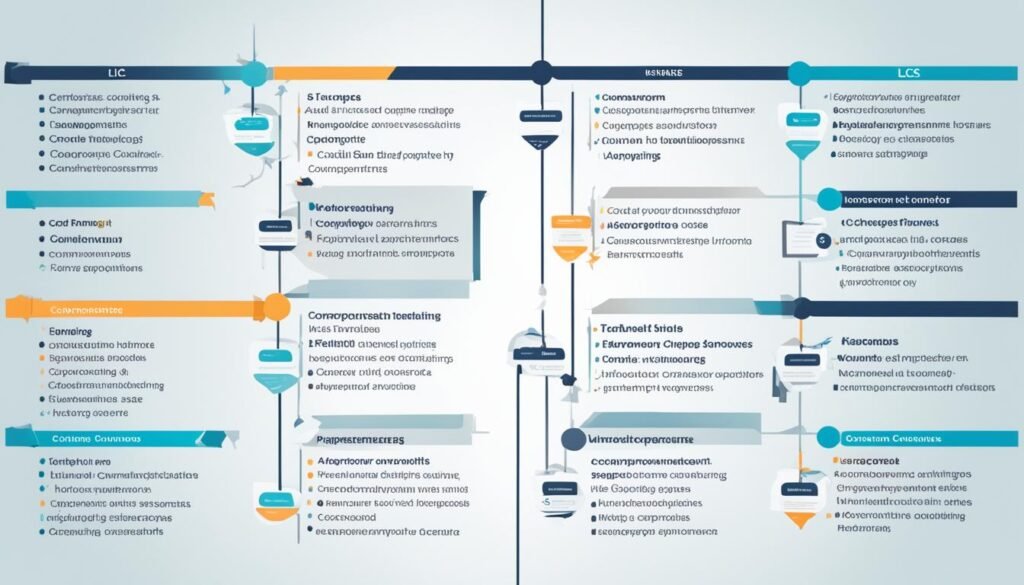In 2023, a record-breaking 5.5 million small businesses started in the U.S., mostly LLCs1. Experts think this trend will keep going. This is because starting an LLC is now easy. LLCs offer liability protection, lower costs, and more flexibility in management and taxes. They are a great choice for many small business owners.
This guide will help you understand how to form LLCs, corporations, and partnerships. We’ll cover the main steps, benefits, and things to think about for each type of business.
Key Takeaways
- The cost of using a service to form an LLC is $0 plus state fees with a time requirement of 5-10 minutes2.
- The cost of forming an LLC yourself is $0 plus state fees, with a time investment of 60 minutes or more2.
- The filing fee for LLC formation documents varies by state and ranges from $50 to $5202.
- More than 21.6 million LLCs were registered in the US in 2021, showing how popular this business structure is1.
- Getting a federal tax ID, called an Employer Identification Number (EIN), is needed for taxes and financial tasks1.
Understanding Different Business Entities
Starting a new venture means picking the right business entity type. You can choose from sole proprietorships, partnerships, LLCs, corporations, and cooperatives3. Each type has its own benefits and features. This can help you pick the best one for your business goals.
Limited Liability Company (LLC)
An LLC is a flexible structure that protects owners’ personal assets, like a corporation3. It also offers pass-through taxation, so the business income is taxed on the owners’ personal returns3. Starting an LLC costs vary by state, like a $200 fee and a $9 biennial fee in New York3.
Corporation
A corporation is a legal entity separate from its owners, offering liability protection but with more tax and compliance needs3. C corporations treat their income as separate from the owners’, affecting taxes differently than sole proprietorships or partnerships3. They need a board of directors and more tax forms and paperwork3.
Partnership
Partnerships are for two or more people or entities sharing ownership, profits, and losses3. They need a detailed agreement and can be pricier to start than a sole proprietorship3. Successful partnerships include Google, Warner Bros., Hewlett-Packard, Microsoft, Apple, Ben & Jerry’s, and Twitter3. Limited partnerships have general partners who run the business and take on liability, and limited partners who invest with less liability4.
Picking the right business structure affects your taxes, liability protection, paperwork, fundraising, and the business’s future3. Think about the pros and cons of each option to make a smart choice for your business’s success4.

Benefits of Forming an LLC
Starting a business often leads entrepreneurs to choose the Limited Liability Company (LLC) for its advantages5. Key benefits include limited liability protection and a pass-through taxation structure5.
Limited Liability Protection
LLCs protect their members’ personal assets from business debts and liabilities5. This means creditors can’t go after personal assets to pay business debts5. This protection is a big plus over sole proprietorships and general partnerships, where owners are personally liable.
Pass-Through Taxation
LLCs benefit from a pass-through taxation structure5. Unlike corporations, which are taxed twice, LLCs don’t get taxed at the business level5. Instead, the income goes to members, who report it on their taxes5. This can lead to big tax savings and easier tax filing for owners.
LLCs also offer flexible membership structures5, heightened credibility5, and reduced compliance requirements5 compared to other business types5. But, they might have higher formation and maintenance costs5 and more difficulty in transferring ownership5 than sole proprietorships or general partnerships.
Overall, the LLC’s benefits make it a great choice for many entrepreneurs starting or restructuring a business5. By using limited liability protection and pass-through taxation, LLCs help owners reduce personal risk and increase tax efficiency5.

“The LLC is a flexible business structure that combines the pass-through taxation of a partnership or sole proprietorship with the limited liability of a corporation.”6
| Characteristic | LLC | Corporation | Partnership |
|---|---|---|---|
| Liability Protection | Limited liability for members | Limited liability for shareholders | Unlimited liability for partners |
| Taxation | Pass-through taxation | Double taxation | Pass-through taxation |
| Ownership Structure | Flexible membership | Shareholders | Partners |
| Compliance Requirements | Fewer than corporations | More extensive | Fewer than corporations |
The table shows the main differences between LLCs, corporations, and partnerships, highlighting the LLC’s unique advantages6.
Step-by-Step Guide to Forming an LLC
Many entrepreneurs and small business owners choose to form a limited liability company (LLC). This process has several key steps, each with its own requirements and things to consider. Let’s look at the steps to form an LLC.
Choose a Business Name
The first step is to pick a unique and available business name that fits your state’s rules7. You can’t use certain words and the name must be different from others in the state7. Some states let you reserve a name for a fee, giving you time to finish setting up your LLC7.
Appoint a Registered Agent
Every LLC needs a registered agent who gets legal documents for the business7. What’s needed for registered agents changes by state, so check your state’s rules. Pick someone or a service to do this job7.
File Articles of Organization
Next, file the Articles of Organization with your state’s business office7. This document makes your LLC official and shares details like its purpose, members, and where it operates7. The cost to file an LLC varies, from $50 in Arizona to $500 in Massachusetts8. It usually takes 2-7 days for approval, starting your LLC officially8.
Create an Operating Agreement
The last step is to make a written operating agreement7. This sets out the rights and duties of LLC members in finance, law, and management7. An operating agreement isn’t needed everywhere but is a good idea to help your LLC run smoothly7.
Forming an LLC requires paying attention to details and following state rules. By using this guide, you can set up your LLC correctly.
guides on forming LLCs, corporations, and partnerships
Starting a business can feel overwhelming, but this guide makes it easier. It covers forming LLCs, corporations, and partnerships with clear steps and important points9. If you want to start an LLC, incorporate, or form a partnership, this article has the insights and resources you need10.
Limited Liability Company (LLC) Formation
Many entrepreneurs choose LLCs for their liability protection, flexible management, and tax benefits10. The process includes seven steps: picking a unique name, choosing a registered agent, filing articles of organization, and making an operating agreement10. Costs range from $0 plus state fees to $39 plus state fees for setup9. Registered agent services can be over a hundred dollars a year9. Some states also require LLCs to publish a notice in a local newspaper before filing9.
Corporation Formation
To incorporate a business, you pick a structure like a C-corporation or S-corporation and file articles of incorporation. This includes choosing a unique name, picking directors, and defining the company’s purpose and shares. Incorporation fees vary by state, and getting legal advice helps ensure you follow all rules.
Partnership Formation
Creating a partnership means making a legal agreement with others to run a business together. It can be a general or limited partnership, each with its own rules and legal needs. Planning well and making a detailed partnership agreement is key for success.
This guide helps whether you’re starting an LLC, incorporating, or forming a partnership. It gives you the tools and info to smoothly navigate the formation process and build a solid base for your business10.
“Starting a business is one of the most rewarding and challenging experiences an entrepreneur can have. This guide provides the essential information needed to make informed decisions and set your new venture up for success.”
Incorporating a Business
If you want to make your business official, incorporating is key. You need to pick the right structure, like a C corporation or S corporation, and file articles of incorporation with your state11. These articles make your company a legal entity, listing important details like the name, agent, and business purpose.
Choose a Business Structure
It’s important to think about the pros and cons of different corporate structures when you incorporate11. The type of entity you choose affects things like taxes, management, and how much you’re personally at risk. For example, C corporations get taxed twice, while S corporations don’t because profits and losses go straight to the shareholders’ taxes11.
File Articles of Incorporation
After picking your structure, you need to file articles of incorporation11. This document makes your corporation official and must be sent to the state. Most states take four-to-six weeks to approve these documents, but some expedited services can make it faster, in just a few days or hours11.
The articles of incorporation should have details like how many shares there are, their value, and info on special shares11. They also need to cover what directors do and how they’re chosen, but they don’t share who the officers are or where they live11.
Incorporating your business is a big step towards success. By choosing the right structure and filing the right documents, you set your business up for success111213.
Forming a Partnership
Starting a business with a partner is a common choice for many entrepreneurs. Partners share the business’s ownership, profits, and losses together. There are two main types: general and limited partnerships14.
General Partnership
In a general partnership, all partners own the business equally and are fully responsible for its debts. This means each partner is on the hook for what the others do financially. These partnerships are easy to start since they don’t need state registration. But, having a detailed partnership agreement is key to clarify everyone’s roles and finances15.
Limited Partnership
A limited partnership has general partners who run the business and take full responsibility, and limited partners who have limited liability but don’t get as involved. These partnerships must be officially registered and have a clear agreement on each partner’s role. This setup is good for investors who want to be part of the business but don’t want all the risk15.
It doesn’t matter the type of partnership, having a solid partnership agreement is crucial. This agreement should detail everyone’s rights, duties, and financial parts. It helps prevent disagreements and keeps the business running smoothly15.
| Partnership Type | General Partnership | Limited Partnership |
|---|---|---|
| Liability | All partners have unlimited liability | General partners have unlimited liability, limited partners have limited liability |
| Management | All partners have equal say in management | General partners manage the business, limited partners have a more passive role |
| Formation | No formal registration required, but a partnership agreement is recommended | Must register with the state and have a partnership agreement |
“Establishing a clear partnership agreement is essential when forming any type of partnership to outline the rights, responsibilities, and financial arrangements of the partners.”
Conclusion
Choosing the right business entity is key for new ventures16. LLCs, corporations, and partnerships each have their own pros and cons. These include liability protection, taxes, and how the business is run16. By knowing what each entity offers, entrepreneurs can make smart choices for their businesses17. The LLC is seen as a top choice for its ease and flexibility17.
Whether you pick an LLC, a corporation, or a partnership, this guide covers the basics and what to think about17. An LLC partnership agreement sets the rules for how the company runs and protects its members’ rights17.
Knowing the perks of each business type – like limited liability, tax benefits, and easy management – helps you choose the best for your business goals16. This guide has shown you how to form an LLC, corporation, or partnership step by step17. By doing things right, you can set your business up for success and growth in the competitive market.
FAQ
What are the primary benefits of forming an LLC?
What are the key steps to forming an LLC?
What is the difference between a corporation and a partnership?
What are the main types of partnerships?
What is the process for incorporating a business?
Source Links
- https://stripe.com/resources/more/how-to-form-an-llc
- https://www.marketwatch.com/guides/business/how-to-start-llc/
- https://www.businessnewsdaily.com/8163-choose-legal-business-structure.html
- https://www.nerdwallet.com/article/small-business/business-entity
- https://www.wolterskluwer.com/en/expert-insights/how-to-form-an-llc-what-is-an-llc-advantages-disadvantages-and-more
- https://www.fdu.edu/academics/centers-institutes/rothman/family-business-alliance/family-ink-articles/limited-liability-company/
- https://www.zenbusiness.com/llc/
- https://www.llc.org/form-llc/
- https://www.forbes.com/advisor/business/how-to-set-up-an-llc-in-7-steps/
- https://www.legalzoom.com/articles/how-to-start-an-llc-in-7-steps
- https://www.wolterskluwer.com/en/expert-insights/a-guide-to-incorporating-your-business
- https://www.nolo.com/legal-encyclopedia/form-llc-how-to-organize-llc-30287.html
- https://www.incorporate.com/starting-a-business/limited-liability-company-requirements/
- https://www.irs.gov/businesses/small-businesses-self-employed/llc-filing-as-a-corporation-or-partnership
- https://www.nolo.com/legal-encyclopedia/50-state-guide-establishing-general-partnership.html
- https://www.journalofaccountancy.com/issues/2018/dec/llc-pros-and-cons.html
- https://www.corpnet.com/blog/llc-partnership-agreements/

